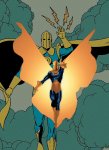Q: "See, it's the "clear literary antecedants" part that I have a problem with. Vance is a bloody obscure source. TX7231 is trying to claim that no one in the 70's would have read Mary Stewart. Never mind that she was a New York Times best selling author and that her Arthur works have made it onto more than one university lit syllabus. Just because he hasn't heard of her, he's assuming that no one has."
You seem to keep missing the point. AD&D was based on creating a recognizable fantasy world (heavily based in the "typical fairy tale", "knights in shining armor", setting....why? Ask EGG. I suspect because they liked that setting, it was easily understandable by anyone who grew up reading fairy tales and popular fantasy like "The Hobbit". So why the heavy constraints (weapons and armor limits etc.)? My guess, to protect the image of that particular setting. And to give players roles that required them to work together to reach particular goals (some sit back and cast spells, others fight hand to hand, while others scout ahead and get past locks and traps). For what ever reason, Gygax and Arneson wanted a world where magicians ran around in robes with staves, fighters carried big swords and wore the heaviest armor possible, thieves were sneaky SOBs in light leather and were lightly armed, and clerics in armor but not so heavily into hand to hand combat. AD&D was a game heavily rooted in mental imagery.
3E lost that setting somewhat. Partly its evident in the new artwork, but also its in the rules, as the old roles no longer exist as clearly as the once did. As if suddenly you went to your lawyer and he not only gave legal advice, but set a sprain.
To continue discussing this topic I think we'll need to come to some vocabulary agreement, otherwise we won't really know what the other is saying. So, for the sake of arguement can we agree on these definitions:
Archetype- a typical example of something we collectively recognize (and in terms of the game, the roles are protected by constraints). In AD&D 1E they are the classes.
*I think we can leave out the jungian and anthropological elements for now. It was an aside really.
Type- a person who seems to represent a particular group of people, having all the qualities that you usually connect with that group (a magician has his staff, robe and hat is a type etc.):
Stereotype-a simplified and standardized conception or image. A fixed idea that people have about what someone or something is like, especially an idea that is wrong:
racial/sexual stereotypes.
So, by the above definitions (taken from websters) an archetype is a set role (the prototype). a type is a person in that set role that looks like it, and a stereotype is the fixed ideas about how we think a person is like (right or wrong).
Can we agree on these?
Personality is brought in by the player and can run the full gambet. It can be the players personality teleported into the game, or it could be someone acting and getting into some other personality to "get into character".
Hussar, the Conan world had some strange magicians in general. I don't consider that world the basis of the one in 1E (though you could say it was an influence, as is greek mythology etc.). Anyhow, great pic!



